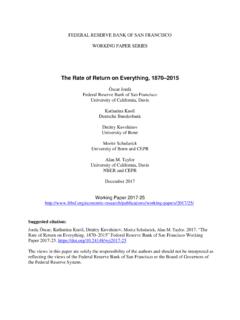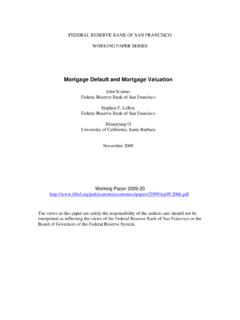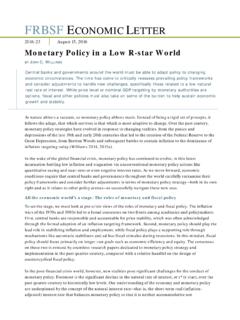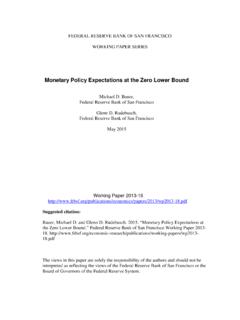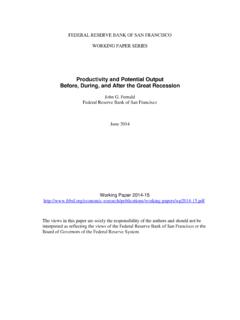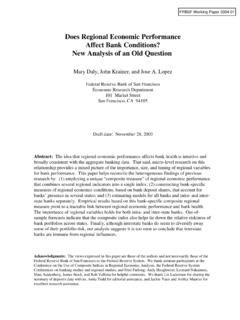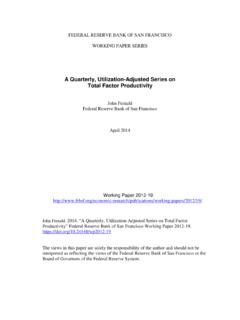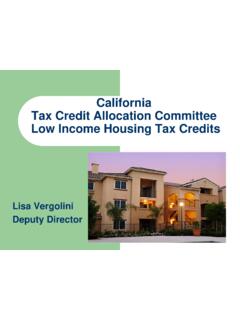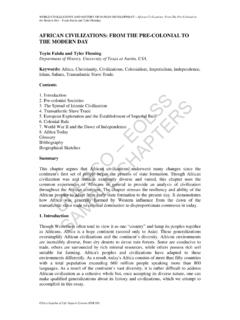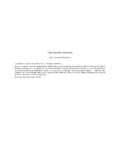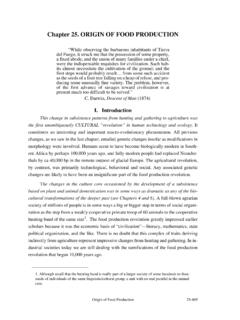Transcription of Longer-Run Economic Consequences of Pandemics
1 FEDERAL RESERVE BANK OF SAN FRANCISCO. WORKING PAPER SERIES. Longer-Run Economic Consequences of Pandemics scar Jord . Federal Reserve Bank of San Francisco University of California, Davis Sanjay R. Singh University of California, Davis Alan M. Taylor University of California, Davis NBER and CEPR. June 2020. Working Paper 2020-09. Suggested citation: Jord , scar, Sanjay R. Singh, Alan M. Taylor. 2020. Longer-Run Economic Consequences of Pandemics , Federal Reserve Bank of San Francisco Working Paper 2020-09. The views in this paper are solely the responsibility of the authors and should not be interpreted as reflecting the views of the Federal Reserve Bank of San Francisco or the Board of Governors of the Federal Reserve System.
2 Longer-Run Economic Consequences of Pandemics ? O scar Jorda Sanjay R. Singh Alan M. Taylor . June 2020. Abstract What are the medium- to long-term effects of Pandemics ? How do they differ from other Economic disasters? We study major Pandemics using the rates of return on assets stretching back to the 14th century. Significant macroeconomic after-effects of Pandemics persist for decades, with real rates of return substantially depressed, in stark contrast to what happens after wars. Our findings are consistent with the neoclassical growth model: capital is destroyed in wars, but not in Pandemics ; Pandemics instead may induce relative labor scarcity and/or a shift to greater precautionary savings.
3 JEL classification codes: E43, F41, I10, N10, N30, N40, O40. Keywords: Pandemics , wars, depressions, real interest rate, natural rate, local projections. ? We are grateful to Robert Allen, Gregory Clark, Paul Schmelzing, and the Bank of England for making their datasets publicly available. All errors are ours. The views expressed herein are solely those of the authors and do not necessarily represent the views of the Federal Reserve Bank of San Francisco or the Federal Reserve System. Federal Reserve Bank of San Francisco and Department of Economics, University of California, Davis Department of Economics, University of California, Davis Department of Economics and Graduate School of Management, University of California, Davis; NBER.
4 And CEPR 1. Introduction How should we think about the medium- to long-term macroeconomic effects of global Pandemics ? This is an important question for policymakers given the massive Economic fallout from the COVID-19 outbreak. The first instinct is to draw from the experience of previous natural disasters and armed conflicts, for which the twentieth century provides ample evidence. That instinct turns out to be wrong. In this paper we use the history of major Pandemics , major wars, and the rates of return since the 14th century to shed light on this problem.
5 In many studies of Pandemics , analysis has understandably focused on short-term impacts. Even then, direct measures based on data from past episodes are not generally available ( , in the , Meltzer, Cox, and Fukuda, 1999). An alternative would be to look at microeconomic outcomes of a given population in episodes for which high-quality administrative data are available ( , in Sweden, Karlsson, Nilsson, and Pichler, 2014). Absent such data, Economic historians have to use more aggregated data at the regional or national level to study the relationship between pandemic incidence and Economic outcomes ( , the 1918 flu epidemic across states Brainerd and Siegler, 2003; Barro, Ursu a, and Weng, 2020).
6 But again, most historical studies have typically focused on one event in one country or region and have traced local outcomes for up to a decade at most. Of course, the most devastating pandemic of the last millennium, the Black Death, has attracted a great deal of scholarly attention. Economists and historians debate its pivotal role in Economic , social, and political change, particularly in Europe. Events such as the Peasants' Rebellion in England feature centrally in a narrative of rising worker power, and the data speak to an emergence of labor scarcity seen in a positive deviation in the path of real wages.
7 This shock left England with a 25% to 40% drop in labor supply, a roughly 100% increase in real wages, and a decline in rates of return on land from about 8% to 5% (Clark, 2007, 2010). But it is an open question how representative the macroeconomic responses in the case of the Black Death are of large Pandemics in general. 1. Figure 1: Nineteen major pandemic events from the past with at least 100,000 estimated deaths Black Death (1331 1353). g Spanish flu (1918 1920). wc Asian flu (1957 1958). bv b Encephalitis lethargica pandemic (1915 1926).
8 R Plague in Kingdom of Naples (1656 1658). a Third cholera pandemic (1852 1860). Russian flu (1889 1890). t Hong Kong flu (1968 1969). t b Sixth cholera pandemic (1899 1923). Plague in Spain (1596 1602). pp Fourth cholera pandemic (1863 1875). Swine Flu (2009). Italian plague (1629 1631). a Great Northern War plague (1700 1721) Range Great Plague of Sevilla (1647 1652) Cirillo-Taleb central estimate p Great Plague of London (1665 1666) Cirillo-Taleb high-low range l Great Plague of Marseille (1720 1722) Other estimates and sources e e First cholera pandemic (1816 1826) Cirillo-Taleb central estimate Second cholera pandemic (1829 1851) (rescaled to 2020 world population).
9 COVID-19 global deaths reach 500,000. on June 28, 2020 (JHU data). 100 1000 10000 100000 1000000. Deaths (thousands). Notes: The main data are taken from the recently published study of Cirillo and Taleb (2020). See the references therein. Additional estimates of pandemic mortality are taken from: (g) George M. Gould and Walter L. Pyle. 1896. Anomalies & Curiosities of Medicine. New York: Bell; (w) Wang-Shick Ryu. 2017. Molecular Virology of Human Pathogenic Viruses. Amsterdam: Academic Press. (c) CDC. ; (b) Encyclopaedia Britannica; (v) Ce cile Viboud et al.
10 2016. Global Mortality Impact of the 1957 1959 Influenza Pandemic; Journal of Infectious Diseases 213(5):738 45; (r) Ravenholt and Foege. 1982. 1918 influenza, encephalitis lethargica, parkinsonism. Lancet 2(8303):860 864; (a) Alfani and Murphy (2017); (t) Paul V. Targonski and Gregory A. Poland. 2017. Influenza. In International Encyclopedia of Public Health, 2nd ed., edited by William C. Cockerham. Amsterdam: Academic Press. (p) Stanley G. Payne. 1973. A History of Spain and Portugal. Madison, Wisc.: University of Wisconsin Press.
